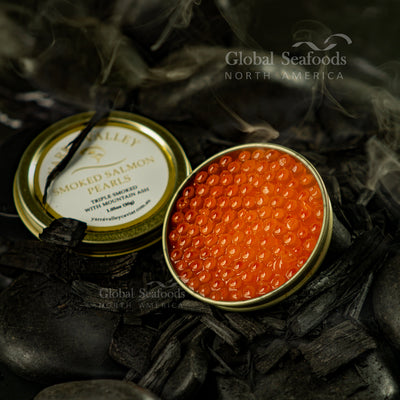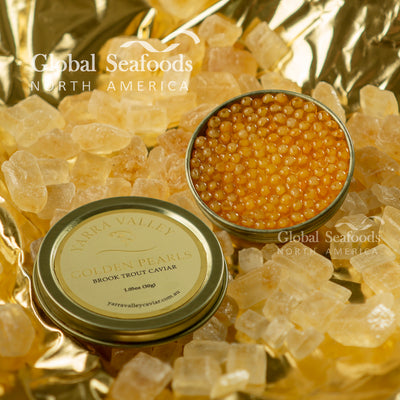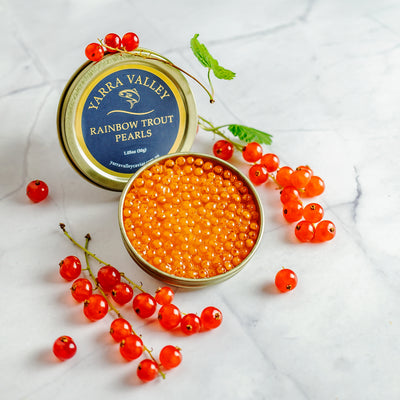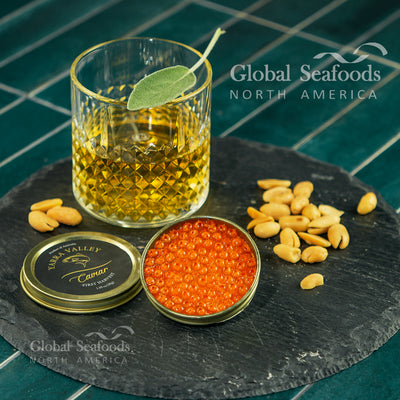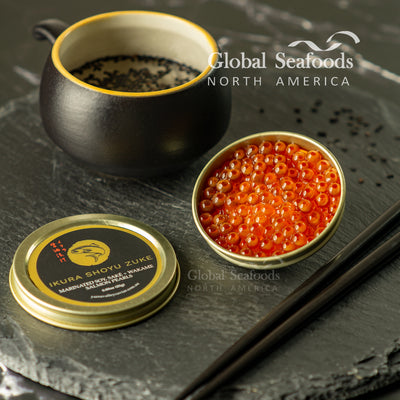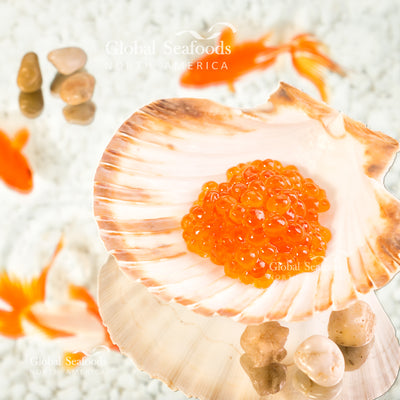Ikura Risotto: A Creamy and Flavorful Recipe You Must Try

Ikura Risotto: Recipe
Ikura, or salmon roe, is an ingredient renowned for its briny, oceanic flavor and vibrant orange color. Traditionally used in Japanese cuisine, ikura can also be the star of other dishes when paired with the right ingredients. One such dish is ikura risotto—a creamy, rich Italian classic enhanced with the delicate pop of fresh salmon roe. This fusion dish combines the best of both culinary worlds, bringing a burst of umami flavor to every bite.
In this article, we’ll dive deep into how to make a creamy ikura risotto, share the health benefits of using salmon roe in your cooking, and explore tips for sourcing the highest quality ingredients. Whether you’re a fan of risotto or looking to explore new ways to enjoy seafood, this dish is perfect for adding a gourmet twist to your meals.
Why Ikura Makes the Perfect Addition to Risotto
Risotto, with its rich and creamy texture, is the ideal canvas for a wide range of flavors. Adding ikura to risotto brings an unexpected burst of brininess that elevates the dish to a new level. The creaminess of the risotto contrasts beautifully with the firm texture and salty flavor of the ikura, making this dish both indulgent and balanced.
Quote from Expert:
Chef Massimo Bottura, one of Italy’s most famous chefs, believes that food should always surprise and delight: “Great cuisine isn’t just about taste, it’s about creating an experience.” Ikura risotto does just that by blending the creamy richness of Italian risotto with the fresh, bold flavors of the sea.
Ingredients for Ikura Risotto
Here’s what you’ll need to prepare a delicious ikura risotto for 2-4 servings:
Main Ingredients:
- 1 cup Arborio rice (the best rice for creamy risotto)
- 3 oz ikura (salmon roe) – Find fresh ikura at Global Seafoods
- 4 cups of low-sodium chicken or vegetable broth
- 1 small shallot, finely chopped
- 1/2 cup dry white wine (such as Sauvignon Blanc)
- 2 tablespoons unsalted butter
- 1/2 cup grated Parmesan cheese
- 2 tablespoons olive oil
- 1 tablespoon lemon juice (optional, for added brightness)
- Fresh chives or dill for garnish
- Salt and black pepper to taste
Optional Add-Ins:
- Cream cheese or mascarpone for an extra creamy texture
- Sautéed mushrooms for an earthy flavor contrast
- Avocado slices for added richness
For high-quality ikura, we recommend trying options like Chum Salmon Caviar or Coho Salmon Caviar from Global Seafoods.
How to Make the Perfect Ikura Risotto: Step-by-Step Guide
Step 1: Preparing the Broth
To create the creamy consistency that risotto is known for, you’ll need to slowly incorporate warm broth into the rice.
- Heat the chicken or vegetable broth in a separate pot over low heat and keep it warm throughout the cooking process.
- This step ensures that the risotto absorbs the broth evenly without cooling down the rice.
Step 2: Sautéing the Shallots and Rice
- In a large saucepan, heat the olive oil over medium heat.
- Add the finely chopped shallot and sauté until it becomes translucent, about 2-3 minutes.
- Stir in the Arborio rice, making sure to coat each grain with the oil. Toast the rice for 1-2 minutes until the edges become slightly translucent.
Chef’s Tip: Toasting the rice helps release the starch, which gives risotto its creamy texture.
Step 3: Deglaze with White Wine
- Add the dry white wine to the rice and shallots, stirring continuously until the wine is fully absorbed.
- This step adds a layer of acidity to balance the richness of the dish.
Step 4: Adding the Broth Gradually
Now comes the key to perfect risotto—slowly adding the broth.
- Ladle in one cup of warm broth and stir until the liquid is absorbed.
- Repeat this process, adding one ladle of broth at a time and stirring continuously. This should take about 20 minutes until the rice is creamy and al dente.
Step 5: Finishing with Butter and Parmesan
- Once the rice has absorbed most of the broth and reached the desired creaminess, stir in the butter and grated Parmesan cheese.
- Season with salt and pepper to taste. For extra brightness, you can add a squeeze of fresh lemon juice at this stage.
Step 6: Adding the Ikura
Remove the risotto from the heat and let it sit for a minute or two. This step allows the flavors to settle.
- Gently fold in the ikura, being careful not to break the delicate roe. The heat of the risotto will slightly warm the ikura without cooking it.
- Garnish with fresh chives or dill, and add an extra spoonful of ikura on top for presentation.
Why Quality Ikura Matters
The key to making the best ikura risotto lies in sourcing fresh, high-quality salmon roe. Fresh ikura should have a firm, slightly briny flavor that complements the richness of the risotto without overpowering it. Poor-quality or frozen ikura can lose its texture and taste, so it’s crucial to choose the best roe available.
For the finest selection of ikura, visit Global Seafoods, where you can find sustainably sourced salmon roe, including options like Trout Red Caviar and Pink Salmon Caviar.
Health Benefits of Ikura
In addition to its rich flavor, ikura offers numerous health benefits. Here’s why incorporating ikura into your diet can be both delicious and beneficial:
1. High in Omega-3 Fatty Acids
Ikura is packed with omega-3 fatty acids, specifically DHA and EPA, which are known to support heart health, reduce inflammation, and improve brain function. According to the American Heart Association, omega-3s can help lower the risk of cardiovascular disease.
2. Rich in High-Quality Protein
Salmon roe is a great source of high-quality protein, which is essential for muscle repair, immune function, and overall health. The protein in ikura contains all essential amino acids, making it a complete protein source.
3. Packed with Vitamins and Minerals
Ikura is rich in vitamins A, D, and B12, all of which are essential for maintaining good health. Vitamin A supports vision and skin health, while vitamin D aids in calcium absorption and bone health. B12 is critical for energy production and brain function.
Fun Fact: Just one serving of ikura provides over 100% of your daily recommended intake of vitamin B12!
Serving Suggestions for Ikura Risotto
While ikura risotto is a gourmet dish on its own, there are several ways to elevate your meal even further. Here are a few serving suggestions:
- Pair with Champagne: The effervescence of Champagne complements the creamy texture of risotto and the briny pop of ikura.
- Garnish with Microgreens: Add fresh microgreens for a burst of color and a slight peppery taste.
- Serve with Seafood: Pair your ikura risotto with grilled shrimp or scallops for a seafood lover's feast.
Looking for more creative ways to use ikura in your cooking? Check out the Global Seafoods YouTube Channel for more seafood-inspired recipes and tips.
Frequently Asked Questions About Ikura Risotto
1. Can I use other types of caviar for this recipe?
Yes! While ikura is the traditional choice for this dish, you can experiment with other types of roe like Golden Pearls Brook Trout Caviar or Bloody Shiraz Infused Caviar to create different flavor profiles.
2. Is it necessary to cook the ikura?
No, ikura should not be cooked. It’s best added to the risotto after it’s removed from heat to preserve its texture and flavor.
3. How long can I store leftover ikura risotto?
Ikura risotto is best enjoyed fresh. However, you can store leftovers in an airtight container in the refrigerator for up to two days. Keep the ikura separate and add it fresh when serving.
4. Where can I buy high-quality ikura online?
For premium-quality ikura, visit Global Seafoods, where you can find sustainably sourced options like Chum Salmon Caviar and Coho Salmon Caviar.
5. Can I make risotto without wine?
Yes, you can skip the wine and use additional broth for a non-alcoholic version. The acidity in the wine helps balance the richness of the risotto, but a squeeze of lemon can provide a similar effect.
Conclusion: Try This Luxurious Ikura Risotto Recipe Today
Ikura risotto is the perfect dish for anyone looking to elevate their dinner experience with a blend of creamy risotto and the rich, briny flavor of salmon roe. Whether you’re hosting a dinner party or treating yourself to a gourmet meal, this dish is sure to impress.
For the freshest and highest-quality ikura, visit Global Seafoods. And for more seafood recipes, be sure to subscribe to the Global Seafoods YouTube Channel.
Also in Recipes

How to Cook Live Manila Clams at Home: Fresh, Sweet & Delivered Overnight
Discover how to store, clean, and cook Live Manila Clams at home using simple chef techniques. Learn why these Pacific clams are perfect for pasta vongole, steaming, chowders, and more—plus how to order them fresh in a convenient 10 lb bag shipped overnight.

Boiled Crab for Brunch: The Ultimate Guide to Morning Seafood
Discover the joy of Boiled crab for brunch! Learn how to prepare seafood in the morning, its health benefits, and recipes to make your brunch memorable.




